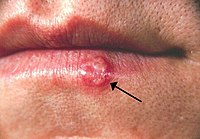
Photo from wikipedia
© BMJ Publishing Group Limited 2022. No commercial reuse. See rights and permissions. Published by BMJ. DESCRIPTION Chikungunya virus (CHIKV) is an emerging arboviral infection with a global distribution with… Click to show full abstract
© BMJ Publishing Group Limited 2022. No commercial reuse. See rights and permissions. Published by BMJ. DESCRIPTION Chikungunya virus (CHIKV) is an emerging arboviral infection with a global distribution with various cutaneous manifestations. The virus can cause infections of the fetus and newborn after maternal CHIKV infections during gestation. An infection rate up to 49% in neonates born from mothers with active viraemia during labour has been observed. Perinatal infection could result in serious complications and potential cognitive impairment. Infected newborns will be either asymptomatic or present symptomatically during their first week of life, but not at the time of birth. 3 Common symptoms can be: fever, irritability, rashes, hyperalgesia syndrome, diffuse limb oedema, bullous dermatitis and occasionally also meningoencephalitis. A newborn presented with dark pigmentation over the face which was more noticeable over centrofacial area (figure 1). There was a history of fever and joint pain in the mother a week before delivery and fever was continued in postpartum period also. An empirical clinical diagnosis of congenital chikungunya was made and was confirmed with IgM antibodies in CHIKV in both newborn and mother. The rare occurrence of cutaneous pigmentation prominent over was the only clue to the retrospective diagnosis of neonatal chikungunya. It can serve as a clue to looking for longterm neurodevelopment delays in symptomatic neonatal CKG infections. In a first of its kind study of skin manifestations of chikungunya H&Estained histopathological preparations of skin biopsy specimens from patients with hyperpigmented lesions showed an intact basal layer with diffuse hypermelanosis of the entire epidermis. There was no melanin incontinence in the dermis, but a sparse perivascular lymphocytic infiltrate was observed. This is suggestive of increased intraepidermal melanin dispersion/retention triggered by the virus. The above para explains the proposed pathomechanism of hyperpigmentation in the index case. Usually the hyperpigmentation resolves by 6–12 weeks. No active treatment is necessary.
Journal Title: BMJ Case Reports
Year Published: 2022
Link to full text (if available)
Share on Social Media: Sign Up to like & get
recommendations!